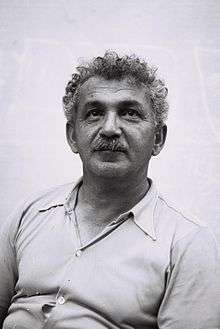Berl Katznelson

Berl Katznelson (Hebrew: ברל כצנלסון, 25 January 1887 – 12 August 1944) was one of the intellectual founders of Labor Zionism, instrumental to the establishment of the modern state of Israel, and the editor of Davar, the first daily newspaper of the workers' movement.
Biography
Katznelson was born in Babruysk, Belarussia, the son of a member of Hovevei Zion. He dreamed of settling in the Jewish homeland from an early age. In Russia, he was a librarian in a Hebrew-Yiddish library and taught Hebrew literature and Jewish history. He made aliyah to Ottoman Palestine in 1909, where he worked in agriculture and took an active role in organizing workers' federations based on the idea of "common work, life and aspirations."[1]
Together with his cousin, Yitzhak Tabenkin, Katznelson was one of the founding fathers of the Israeli workers union, the Histadrut.[2] In this capacity, together with Meir Rothberg of the Kinneret Farm,[3] Katznelson founded in 1916 the consumer co-operative known as Hamashbir with the goal of supplying the Jewish communities of Palestine with food at affordable prices during the terrible shortage years of the First World War.[4] He helped to establish the Clalit Health Services sick fund, a major fixture in Israel's network of socialized medicine. In 1925, together with Moshe Beilinson, Katznelson established the Davar daily newspaper, and became its first editor, a position he held until his death, as well as becoming the founder and first editor-in-chief of the Am Oved publishing house.
Katznelson was well known for his desire for peaceful coexistence between Arabs and Jews in Israel. He was an outspoken opponent of the Peel Commission's partition plan for Palestine.[5] He stated:
I do not wish to see the realization of Zionism in the form of the new Polish state with Arabs in the position of the Jews and the Jews in the position of the Poles, the ruling people. For me this would be the complete perversion of the Zionist ideal... Our generation has been witness to the fact that nations aspiring to freedom who threw off the yoke of subjugation rushed to place this yoke on the shoulders of others. Over the generations in which we were persecuted and exiled and slaughtered, we learned not only the pain of exile and subjugation, but also contempt for tyranny. Was that only a case of sour grapes? Are we now nurturing the dream of slaves who wish to reign?[6]
Katznelson also spoke of Jewish self-hatred, saying:
"Is there another People on Earth so emotionally twisted that they consider everything their nation does despicable and hateful, while every murder, rape, robbery committed by their enemies fill their hearts with admiration and awe?"[7]
Katznelson died of an aneurysm in 1944 and was buried at his request in the cemetery on the shores of the Sea of Galilee, next to Sarah Shmukler.[8]
Memories of Katznelson
In her biography, Golda Meir remembers Berl Katznelson as a pivotal figure in the life of the Jewish community in Palestine: "Berl was not at all physically impressive. He was small, his hair was always untidy, his clothes always looked rumpled. But his lovely smile lit up his face, and [he] looked right through you, so that no one who ever talked to Berl forgot him. I think of him as I saw him, hundreds of times, buried in a shabby old armchair in one of the two book-lined rooms in which he lived in the heart of old Tel-Aviv, where everyone came to see him and where he worked (because he hated going to an office). 'Berl would like you to stop by' was like a command that no one disobeyed. Not that he held court or ever gave orders, but nothing was done, no decision of any importance to the Labour movement in particular or the yishuv in general, was taken without Berl's opinion being sought first."[9]
Commemoration
Katznelson is commemorated in many places, in name. Beit Berl near Tzofit, Ohalo (lit. his tent) on Sea of Galilee, and Kibbutz Be'eri (which takes Katznelson's literary name).[10] Many streets throughout Israel are named in his memory. Israeli Postal Service issued a Berl Katzenelson commemorative stamp. [11][12]
References
- ↑ Encyclopedia of Zionism and Israel, Berl Katzenelson, edited by Raphael Patai, New York, 1971
- ↑ Ben Halpern (March 1988). Yitzhak Tabenkin and Berl Katznelson, Books on Israel. Association for Israel Studies, SUNY Press. pp. 17–22. ISBN 978-0-88706-776-1. Retrieved 7 November 2010.
- ↑ "Kinneret Courtyard".
- ↑ "Hamashbi Hamerkazi".
- ↑ Itzhak Galnoor (1995). The partition of Palestine: decision crossroads in the Zionist movement. SUNY Press. p. 234. ISBN 978-0-7914-2193-2. Retrieved 7 November 2010.
- ↑ Cohen, Aharon (1970). Israel and the Arab World. Funk & Wagnalls Co. pp. 260–261. ISBN 978-0-308-70426-8.
- ↑ Zilber, Uzi (25 December 2009). "The Jew Flu: The strange illness of Jewish anti-Semitism". Haaretz. Retrieved 25 December 2009.
- ↑ Tsur, Muki (March 2009). "Sarah Shmukler". Jewish Women: A Comprehensive Historical Encyclopedia. Jewish Women's Archive. Retrieved 3 November 2010.
- ↑ "My Life, Golda Meir, 1975, pp.98–102
- ↑ Berl Katznelson Jewish Virtual Library
- ↑ Berl Katznelson Archived 13 July 2011 at the Wayback Machine. Famous Portraits on the Stamps of Israel
- ↑ "Berl Katnelson". The complete guide to Israeli postage stamps from 1948 onward. Boeliem.
External links
| Wikimedia Commons has media related to Berl Katznelson. |
- Genealogy of Berl Katznelson from Geni
- Anita Shapira (1984). Berl: the biography of a socialist Zionist, Berl Katznelson, 1887–1944. CUP Archive. ISBN 978-0-521-25618-6. Retrieved 3 November 2010.
